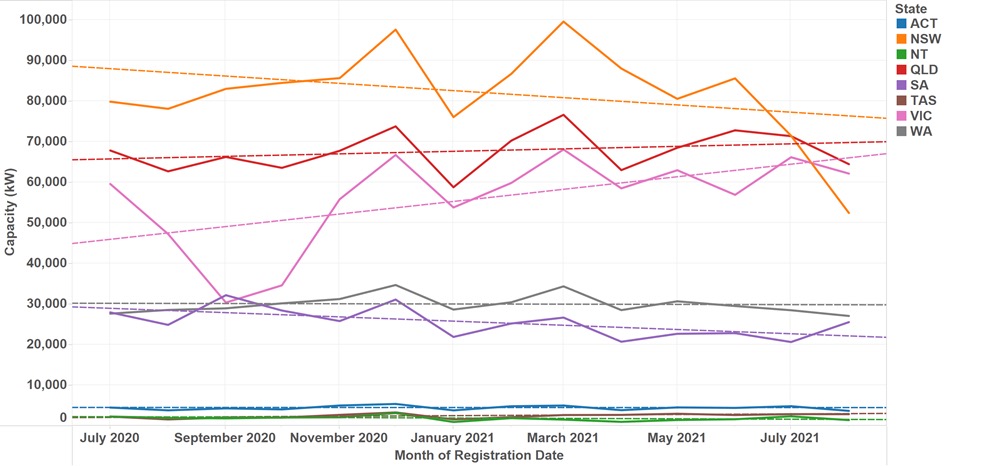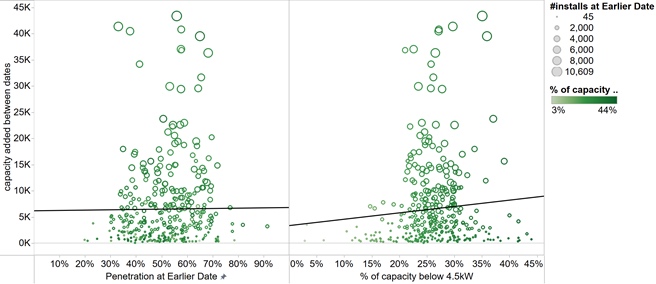By now you may have seen SunWiz’s data pointing towards a slowdown in the rooftop solar industry, with a dip in installations in August, and Covid-hit NSW falling to third spot behind Victoria and Queensland.
Lockdowns in Australia’s most populous states have been the prime cause of the downturn in rooftop installations in recent months. That’s been keenly felt in NSW in particular, which (like Victoria the year before) has seen system registrations fall by half.
But lockdowns aren’t the entire story. The average monthly volumes in 2021 for Queensland and Victoria are essentially a flat line, whereas South Australia has been gradually contracting for almost 12 months running.
This is quite a different picture to the four years of more than 30% compounding growth Australia’s rooftop PV market has enjoyed.
This isn’t an issue of market saturation. SunWiz’s research demonstrates that postcodes with high penetration are equally likely to install more capacity as are postcodes with low penetration.
Our research also demonstrates more capacity is being installed in locations that had smaller systems, implying a renaissance is hitting suburbs that took up PV over 7 years ago.
The chart below plots the capacity added between January 2019 and July 2021 (vertical axis) for each Queensland postcode against the January 2019 penetration into suitable dwellings for that postcode (horizontal axis of left pane), and against the January 2019 percentage of capacity that was below 4.5kW in each postcode.
There’s a few factors at play here, beyond lockdowns.
- Last year’s figures were buoyed by financial stimulus and home-improvement projects. This ‘brought-forward’ into 2020 customers who might otherwise have purchased in 2021
- There’s significant economic uncertainty right now, and employment has been hit, both of which can hamper people’s desire to spend thousands of dollars – despite the fact savings from a PV system more than covers its financing repayments.
- The headlines regarding a ‘sun-tax’ haven’t helped. Nor has the threat of remote switch-off of PV systems in SA. Nor the increasing amount of export limitations.
- Electricity prices are falling as renewable energy drives down wholesale prices, which flows through to reduce feed-in tariffs.
Rooftop PV remains incredibly popular, and is likely to be for many years to come. Though lockdowns may end in coming months, some long-term changes are afoot, so I suspect the joyride of years of 30+% annual growth are over.
Solar businesses need to adapt to the new market dynamics, and can do so by adapting smarter approaches.
Plenty of solar industry veterans have been through this before, and know what to do to survive. It is possible to thrive during these times – inevitably some solar businesses will outperform the market and set themselves up for years to come. You just need to listen to the people who’ve been through this before.
Note: You can hear more about how the solar industry is tackling the current conditions in Nigel Morris’ Great Solar Business podcasts. See here: Great Solar Business Podcast: The future of inverters
SunWiz is also hosting a webinar on the issue and has pulled together six industry-leading service providers to offer recommendations. You’ll hear from:
- Nigel Morris (Solar Analytics)
- Warwick Johnston (SunWiz & Sunfluence)
- Katherine McConnell (Brighte)
- Russell French (Energetic Consulting & Sunfluence)
- Maaike Gobel (OpenSolar)
- Sam Craft (NRG Solar)
Register for free here: https://us02web.zoom.us/











